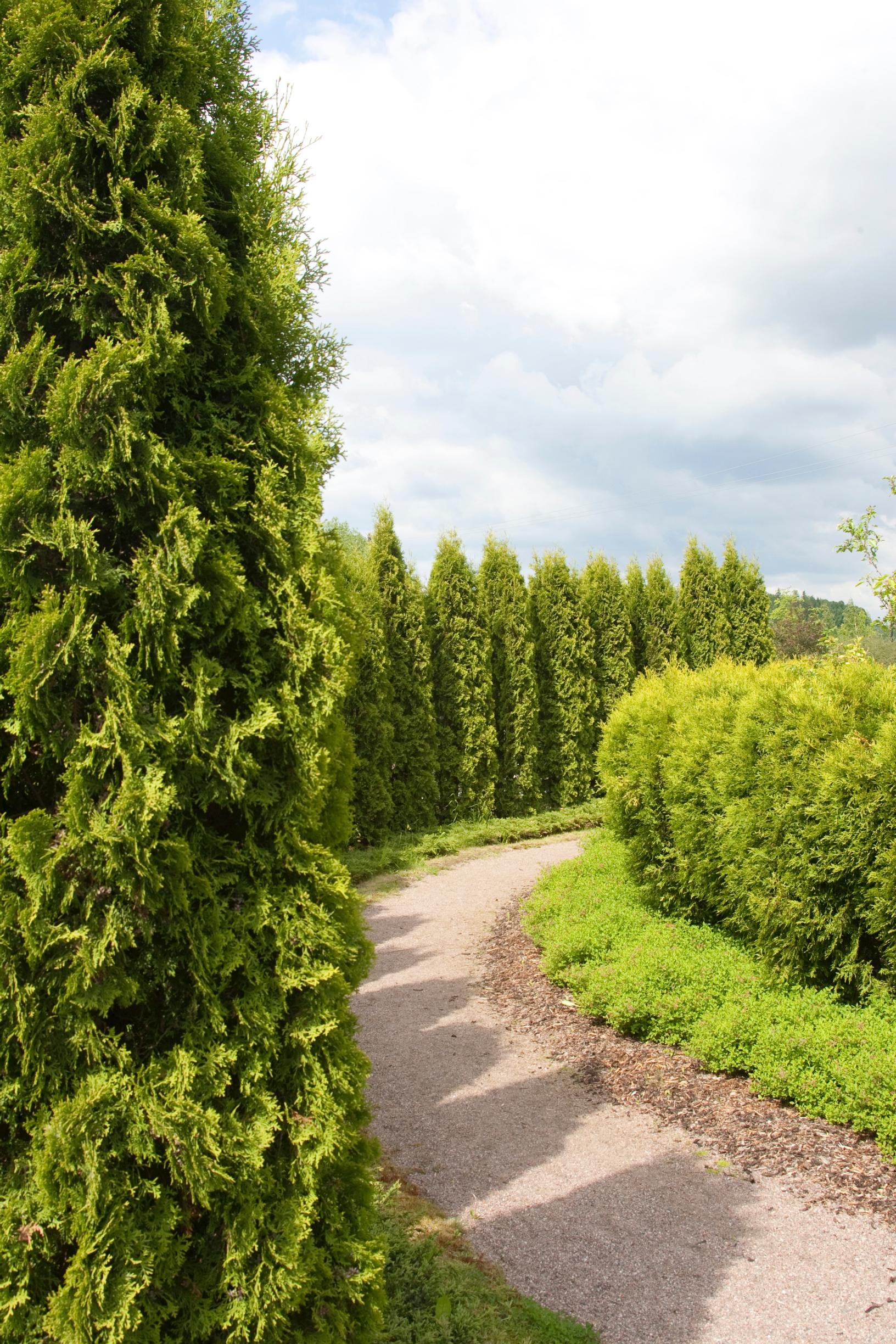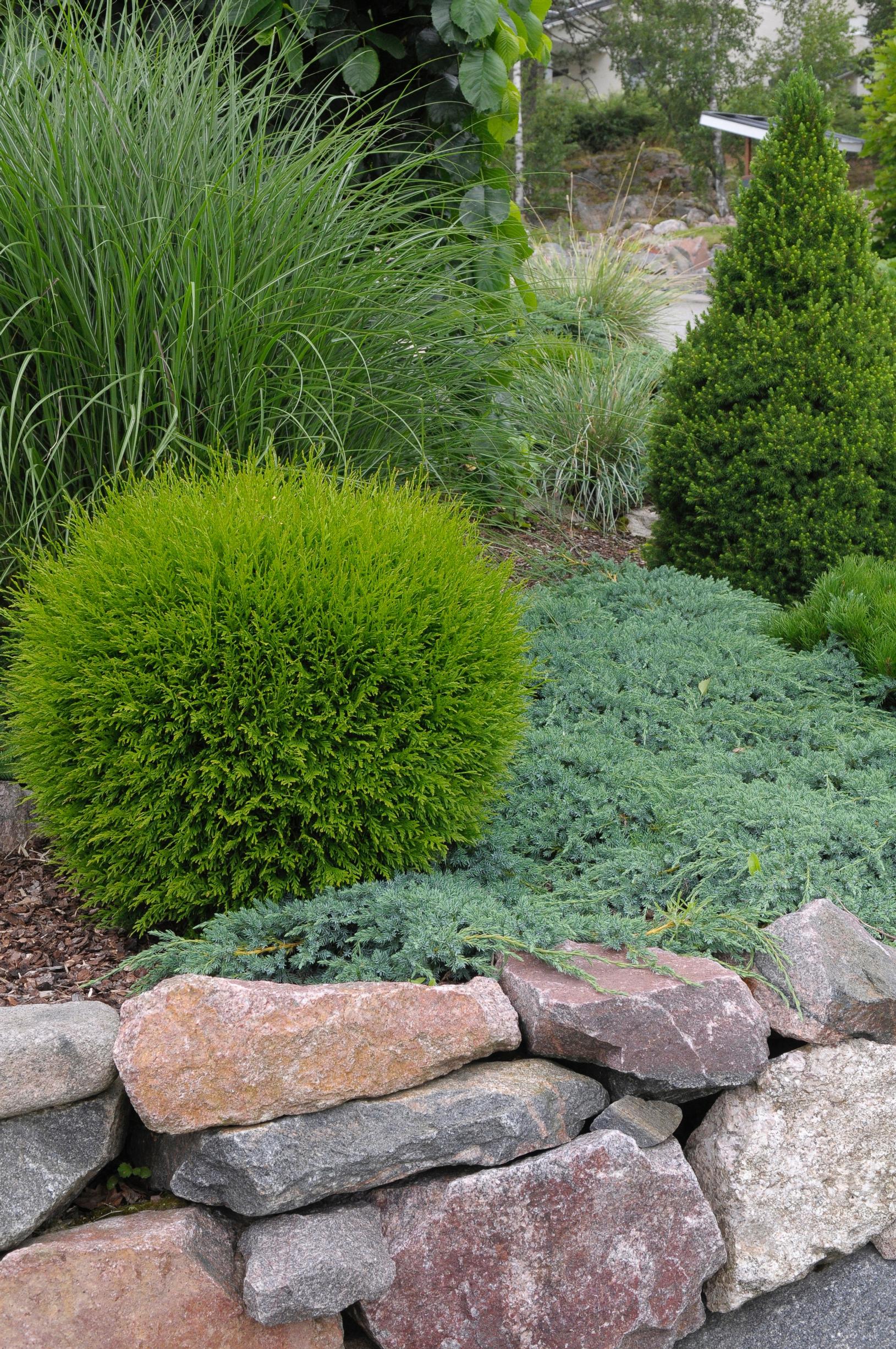
Thuja hedge plants: expert tips for planting, growing, and care
A thuja hedge brings greenery and privacy to your garden. If you’re planning to plant a thuja hedge or need care instructions, check out these expert tips on how to plant a thuja hedge, care for it, and nurture a beautiful and long-lasting conifer hedge.
Thuja hedge plants—choose a suitable growing site
Light conditions
Thuja thrives best in a partially shaded spot. It can also do well in sunny conditions, but in such conditions it’s important for the plant to receive enough water from the soil.
In sunny locations, early spring is particularly problematic because thuja seedlings cannot draw water from the frozen soil, but the sun causes them to lose moisture through their needles. This often leads to browning. You can help prevent these issues by shading the seedlings.
Soil and groundwork
A thuja hedge is often planted as a garden boundary, right at the edge of the lawn. However, the roughly 20-centimeter layer of soil prepared for the lawn isn’t enough for a thuja hedge; the shrubs need a growing medium that is about 40 centimeters deep.
Thuja thrives best in nutrient-rich, moisture-retentive soil. It’s also possible to amend the soil to make it more suitable for a thuja hedge.
If the soil in your garden is:
- Rocky and sandy: Improve the growing medium with potting soil or soil intended for conifers and rhododendrons, which retains water and provides nutrients to poor sandy soil.
- Clay: Lay a drainage pipe at the bottom of the planting trench to direct excess water away. Improve the drainage of the clay soil with sand, and mix in some garden soil to enhance the crumb structure of the growing medium.

Planting a thuja hedge
- Dig a trench for the hedge seedlings into which they can be planted in a continuous row. The trench should be at least 40 centimeters deep and twice as wide as the seedlings’ root balls. By creating a single, uniform trench, you ensure the roots have a good environment and aren’t forced to compete with weeds or lawn for water and nutrients.
- Improve the soil you removed from the planting hole by mixing in some topsoil or sand. Shovel this mixture onto the bottom of the planting trench.
- Water the thuja seedlings thoroughly before planting. Place them in a row on top of the soil layer. About 30 centimeters apart is ideal for a thuja hedge to form a dense barrier quickly.
- Remove the pot from container-grown seedlings, but leave the mesh around root-balled seedlings. Plant them at the correct depth: container seedlings should be planted at the same depth as in the pot, while root-balled seedlings should have the root collar exposed. Shovel soil around each seedling and firm it down.
- Check that the seedlings are standing straight and press them firmly into the growing medium. Level the surface of the soil and water thoroughly so the soil settles around the roots and the root system makes good contact with the ground. Add more soil if needed.
- Finally, spread about a five-centimeter layer of bark mulch on top to help reduce water evaporation.
Remember to water!
Water the hedge regularly throughout the first growing season so the seedlings won’t suffer from drought. The best way to ensure consistent watering is to install drip irrigation tubing along the hedge. By timing the watering properly, water can soak into the soil before evaporating, even on hot summer days.
Caring for a thuja hedge
Pruning thuja hedge plants
A thuja hedge will grow more densely if it’s pruned every year. The best time to prune is in early spring, between March and April, before the new growing season begins.
Each year, trim the sides of the hedge to tidy up the previous year’s growth. Follow the plant’s natural shape, forming the hedge into a cone shape—narrower at the top and wider at the base. This way, the lower branches also receive light and retain their needles.
Once the hedge has reached your desired height, cut off the top. After that, prune the top every year, leaving a few centimeters of the previous year’s growth.
If necessary, you can tidy the hedge again after midsummer.
Fertilizing thuja hedge plants
Fertilize your thuja hedge every spring before growth begins, using a fertilizer designed for conifers. If necessary, you can also apply an autumn fertilizer in late summer to help the plants overwinter.
Protecting thuja hedge plants
It’s advisable to protect newly planted hedge seedlings in spring for at least the first couple of years, because their root systems don’t yet extend below the frost line.
The warmth of the spring sun awakens the green parts of the thuja, causing them to transpire. Since the ground is still frozen, the roots cannot supply replacement water, leading to drying and browning of the green parts. The problem is further exacerbated by dry winds for seedlings planted in windy locations.
Use a shade net designed for evergreens. Place it over the thuja seedlings in early spring, when the sun becomes stronger. Remove the net only after the ground has thawed around the hedge seedlings.

Different thuja varieties
- The best thuja varieties for hedges are usually conical thuja. Among those, ‘Brabant’ is the fastest-growing, while ‘Holmstrup’ grows at a more moderate rate. In addition, ‘Pyramidalis’ and ‘Pyramidalis Compacta’ are also available. The ‘Smaragd’ variety is dense and best suited as a standalone plant or for container growing. Depending on variety, these thujas can be grown in Finnish hardiness zones I–III(IV). (You can read about the Finnish hardiness zones here.)
- Narrow, pillar-shaped varieties include ‘Columna’ and ‘Fastigiata’. They don’t take up much space, so pillar-shaped thuja are perfect for small gardens. Hardiness zones: I–IV(V).
- Globular thuja grows into a lovely globe shape. There are several varieties: ‘Danica’, ‘Globosa’, ‘Hoveyi’, ‘Little Champion’, ‘Little Giant’, ‘Recurva Nana’, ‘Tiny Tim’ and ‘Woodwardii’. They can thrive in zones I–IV.
- Green-yellow or orange-yellow varieties are often called golden thuja: ‘Europe Gold’, ‘Golden Globe’, ‘Rheingold’, ‘Sunkist’ and ‘Yellow Ribbon’. These bright varieties pair especially well with green conifers and can add color to flower beds. Hardiness zones: I–III.
- Other species include Korean thuja, giant thuja, Sichuan thuja, and Japanese thuja. The Canadian thuja eventually grows into a large tree.


